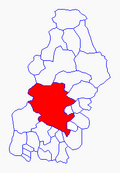Tegucigalpa
| Tegucigalpa | |||
|---|---|---|---|
| City | |||
| Tegucigalpa, Municipio del Distrito Central
Previous names
|
|||
 |
|||
|
|||
| Nickname(s): Tegus,Tepaz,Cerro de Plata (Silver Mountain) | |||
 Location of the Central District within the Department of Francisco Morazán |
|||
| Location of Tegucigalpa, M.D.C. in Honduras | |||
| Coordinates: 14°6′N 87°13′W / 14.100°N 87.217°WCoordinates: 14°6′N 87°13′W / 14.100°N 87.217°W | |||
| Country |
|
||
| Department | Francisco Morazán | ||
| Municipality | Central District | ||
| Founded | 29 September 1578 | ||
| Capital | 30 October 1880 | ||
| Merged as Central District | 30 January 1937 | ||
| Government | |||
| • Type | Mayor-Council | ||
| • Body | Municipal Corporation | ||
| • Mayor | Nasry Asfura (PNH) | ||
| • Vice Mayor | Juan García | ||
| • Aldermen | |||
| • Municipal Secretary | Cosette Lopez Osorio | ||
| Area | |||
| • City | 1,514 km2 (585 sq mi) | ||
| • Urban | 201.5 km2 (77.8 sq mi) | ||
| Elevation | 990 m (3,250 ft) | ||
| Population (2013 census) | |||
| • City | 1,157,509 | ||
| • Density | 760/km2 (2,000/sq mi) | ||
| • Urban | 1,055,729 | ||
| Demonym(s) | Spanish:tegucigalpense, comayagüelense, capitalino(a) | ||
| Time zone | Central America (UTC-6) | ||
| Postal code | Tegucigalpa: 11101, Comayagüela: 12101 | ||
| Area code(s) | (country) +504 (city) 2 | ||
| Annual budget (2008) | 1.555 billion lempiras (US$82,190,000) | ||
| Website | Government of Tegucigalpa | ||
| Central District crime indicators* | ||||
|---|---|---|---|---|
| 2007 | 2008 | 2009 | ||
| Homicide rate | 58.1 | 60.6 | 71.8 | |
| Intentional homicides | 621 | 654 | 792 | |
| Unintentional homicides | 93 | 100 | 151 | |
| Male victim ratio | 89.7% | 91% | 91% | |
| Top victim age group (15–39) | 68.9% | 65.5% | 73.2% | |
| Firearm involvement | 80% | 81% | 85.6% | |
| Organized crime involvement | 14.2% | 26.3% | 39% | |
| Sexual assaults | 577 | 521 | 647 | |
| Crimes against person | 3,791 | 3,746 | 4,471 | |
| Crimes against property | 659 | 3,406 | 7,863 | |
| Suicides | 72 | 64 | 69 | |
| Top suicide age group (15–39) | 48.6% | 35.9% | 47.8% | |
| Vehicle-related deaths | 222 | 235 | 246 | |
| *Data based on crimes reported to authorities. Source: | ||||
Tegucigalpa (Spanish pronunciation: [teɣusiˈɣalpa or teɣuθiˈɣalpa], formally Tegucigalpa, Municipality of the Central District Spanish: Tegucigalpa, Municipio del Distrito Central or Tegucigalpa, M.D.C.), commonly referred to as Tegus, is the capital of Honduras and seat of government of the Republic, along with its twin sister Comayagüela.
Claimed on September 29, 1578 by the Spaniards, Tegucigalpa became the country's capital on October 30, 1880 under President Marco Aurelio Soto. The current Constitution of Honduras, enacted in 1982, names the sister cities of Tegucigalpa and Comayagüela as a Central District to serve as the permanent national capital, under articles 8 and 295.
After a failed attempt to create a Central American republic in 1821, Honduras became an individual sovereign nation. On January 30, 1937, Article 179 of the 1936 Honduran Constitution was changed under Decree 53 to establish Tegucigalpa and Comayagüela as a Central District.
Tegucigalpa is located in the southern-central highland region known as the department of Francisco Morazán of which it is also the departmental capital. It is situated in a valley, surrounded by mountains. Tegucigalpa and Comayagüela, being sister cities, are physically separated by the Choluteca River. The Central District is the largest of the 28 municipalities in the Francisco Morazán department.
Tegucigalpa is Honduras' largest and most populous city as well as the nation's political and administrative center. Tegucigalpa is host to 25 foreign embassies and 16 consulates. It is the home base of several state-owned entities such as ENEE and Hondutel, the national energy and telecommunications companies, respectively. The city is also home to the country's most important public university, the National Autonomous University of Honduras, as well as the national soccer team. The capital's international airport, Toncontín, is known for its extremely short runway and the unusual maneuvers pilots must undertake upon landing or taking off to avoid the nearby mountains.
...
Wikipedia



